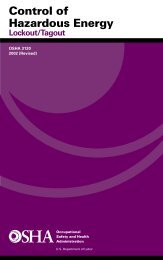Toxic Chemical Release Inventory Reporting Forms and Instructions
Toxic Chemical Release Inventory Reporting Forms and Instructions
Toxic Chemical Release Inventory Reporting Forms and Instructions
You also want an ePaper? Increase the reach of your titles
YUMPU automatically turns print PDFs into web optimized ePapers that Google loves.
Facility Eligibility Determination for Submitting an EPCRA Section 313 Report<br />
facility, not just releases <strong>and</strong> other waste management quantities<br />
from the otherwise use activity.<br />
Also note that threshold determinations are based upon the<br />
actual amounts of an EPCRA section 313 chemical<br />
manufactured, processed, or otherwise used over the course of<br />
the calendar year. The threshold determination may not relate to<br />
the amount of an EPCRA section 313 chemical brought on-site<br />
during the calendar year. For example, if a stockpile of 100,000<br />
pounds of a non-PBT EPCRA section 313 chemical is present<br />
on-site but only 20,000 pounds of that chemical is applied to a<br />
process, only the 20,000 pounds processed is counted toward a<br />
threshold determination, not the entire 100,000 pounds of the<br />
stockpile.<br />
B.4.b. Threshold Determinations<br />
for On-Site Reuse Operations<br />
Threshold determinations of EPCRA section 313 chemicals that<br />
are reused at the facility are based only on the amount of the<br />
EPCRA section 313 chemical that is added during the year, not<br />
the total volume in the system. For example, a facility operates<br />
a refrigeration unit that contains 15,000 pounds of anhydrous<br />
ammonia at the beginning of the year. The system is charged<br />
with 2,000 pounds of anhydrous ammonia during the year. The<br />
facility has therefore “otherwise used” only 2,000 pounds of<br />
anhydrous ammonia, a non-PBT EPCRA section 313 chemical,<br />
which is below the otherwise use threshold for anhydrous<br />
ammonia <strong>and</strong> is not required to report (unless there are other<br />
“otherwise use” activities of ammonia, that when taken together,<br />
exceed the reporting threshold). If, however, the whole<br />
refrigeration unit was recharged with 15,000 pounds of<br />
anhydrous ammonia during the year, then the facility would have<br />
exceeded the otherwise use threshold, <strong>and</strong> would be required to<br />
report.<br />
This does not apply to EPCRA section 313 chemicals “recycled”<br />
or “reused” off-site <strong>and</strong> returned to a facility. Such EPCRA<br />
section 313 chemicals returned to a facility are treated as the<br />
equivalent of newly purchased material for purposes of EPCRA<br />
section 313 threshold determinations.<br />
B.4.c. Threshold Determinations for Ammonia<br />
The listing for ammonia includes the modifier "includes<br />
anhydrous ammonia <strong>and</strong> aqueous ammonia from water<br />
dissociable ammonium salts <strong>and</strong> other sources; 10% of total<br />
aqueous ammonia is reportable under this listing". The qualifier<br />
for ammonia means that anhydrous forms of ammonia are 100%<br />
reportable <strong>and</strong> aqueous forms are limited to 10% of total<br />
aqueous ammonia. Therefore, when determining threshold<br />
quantities, 100% of anhydrous ammonia is included but only<br />
10% of total aqueous ammonia is included. If any ammonia<br />
evaporates from aqueous ammonia solutions, 100% of the<br />
evaporated ammonia is included in threshold determinations.<br />
For example, if a facility processes aqueous ammonia it has<br />
processed 100% of the aqueous ammonia in that solution. If<br />
the ammonia remains in solution, then 10% of the total aqueous<br />
ammonia is counted towards threshold. If there are any<br />
evaporative losses of anhydrous ammonia, then 100% of those<br />
losses must be counted towards the processing threshold. If the<br />
manufacturing, processing, or otherwise use threshold for the<br />
ammonia listing are exceeded, the facility must report 100% of<br />
these evaporative losses in Sections 5 <strong>and</strong> 8 of the Form R.<br />
B.4.d. Threshold Determinations<br />
for <strong>Chemical</strong> Categories<br />
A number of chemical compound categories are subject to<br />
reporting. See Table IIc for a listing of these EPCRA section<br />
313 chemical categories. When preparing threshold<br />
determinations for one of these EPCRA section 313 chemical<br />
categories, all individual members of a category that are<br />
manufactured, processed, or otherwise used must be counted.<br />
Where generic names are used at a facility, threshold<br />
determinations should be based on CAS numbers. For<br />
example, Poly-Solv EB does not appear among the reportable<br />
chemicals in Table IIa or IIb but its CAS number indicates<br />
Poly-Solv EB is a synonym for ethylene glycol mono-n-butyl<br />
ether, a member of the certain glycol ethers chemical category<br />
(code N230). For chemical compound categories threshold<br />
determinations must be made separately for each of the three<br />
activities. Do not include in these threshold determinations for<br />
a category any chemicals that are also individually listed<br />
EPCRA section 313 chemicals (see Table IIa or IIb) or<br />
chemicals that have been deleted from a category (e.g., a class<br />
of copper phthalocyanine compounds has been deleted from the<br />
copper compounds category). Individually listed EPCRA<br />
section 313 chemicals are subject to their own, individual<br />
threshold determination.<br />
Organic Compounds<br />
For the organic compound categories, you are required to<br />
account for the entire weight of all compounds within a<br />
specific compound category (e.g., glycol ethers) at the facility<br />
for BOTH the threshold determination <strong>and</strong> release <strong>and</strong> other<br />
waste management estimates.<br />
Metal Category Compounds<br />
Threshold determinations for metal category compounds<br />
present a special case. If, for example, your facility processes<br />
several different nickel compounds, base your threshold<br />
determination on the total weight of all nickel compounds<br />
processed. However, if your facility processes both the<br />
“parent” metal (nickel) as well as one or more nickel<br />
compounds, you must make threshold determinations for both<br />
nickel (CAS number 7440-02-0) <strong>and</strong> nickel compounds<br />
(chemical category code N495) because they are separately<br />
<strong>Toxic</strong>s <strong>Release</strong> <strong>Inventory</strong> <strong>Reporting</strong> <strong>Forms</strong> <strong>and</strong> <strong>Instructions</strong> 23
















